|
Module 15 |
Updated: 07/04/2005 |
|
Principles Knowledge of the physics of color will add to the effectiveness of your work and help eliminate production problems. In fact, it will help you with everything from color-balancing a video camera to color-coordinating your wardrobe. First, note from the illustration below that visible light represents only a small portion of the electronic spectrum. This is a spectrum of energy that starts with low frequency radio waves, moves through VHF-TV, FM radio, UHF-TV (which now includes the new digital TV band of frequencies), all the way through x-rays.
The visible light portion of the electromagnetic spectrum consists of all the colors of the rainbow (as shown in the enlarged segment above), which combine to produce white light. The fact that white light consists of all colors of light added together can be demonstrated with the help of a prism. If you project white light through a prism, as illustrated below, the light will be expanded to show the individual color components within the light.
Conversely, the opposite is also true: if you add all of the basic colors of light together, you can create white light. By keeping these concepts in mind, you will have the key to the additive color television process. Before we get further into the additive color process-a process
that's basic to color television-we need to take a look at a process that's probably
better understood: the subtractive color process.  Subtractive Color
Subtractive Color
The color of an object is determined
by the colors of light When white light falls on a red object, the object appears red because its surface subtracts (absorbs) all colors of light except red. The light that is absorbed (subtracted) is transformed into
heat. This explains why a black object, which absorbs all of the colors of light
hitting it, gets much hotter in sunlight than a white object that reflects all colors.
When the primary subtractive colors of cyan, yellow and magenta pigments are mixed together, the result is black-or, because of impurities in the pigments, a dark shade of something resembling mud. To solve the "mud" problem, sophisticated color printing processes use CYMK, with "K" standing for black. With either process all color is essentially absorbed where all of the inks or pigments overlap, as seen in this illustration. Also note what happens when you mix the three primary subtractive color pigments (yellow, cyan and magenta). You can see that yellow and cyan produce green, magenta and cyan produce blue, etc.
When a colored filter or gel is placed over a camera lens or light, the same type of color subtraction takes place. For example, a pure red filter placed over a camera lens will absorb all colors of light except red. Many people erroneously assume that the red filter simply "turns all of the light red," which, as you can see, is not the case. |
|
Additive Color Thus far we have been talking about the effect of mixing paints or pigments that absorb (subtract) light. When colored lights are mixed (added) together, the result is additive rather than subtractive. Thus, when the additive primaries (red, green and blue light) are mixed together, the result is white.
When all three primary colors overlap (are added together) on a white screen, the result is white light. Note in this illustration that the overlap of two primary colors (for example, red and green) creates a secondary color (in this case, yellow). The standard color wheel is
the key to understanding many issues Red, green and blue are TV's primary colors, and yellow, magenta, and cyan are considered secondary colors. If you take the time to memorize the color wheel on the left, you will find it useful in many areas-not just TV. If any two colors exactly opposite each other on the color wheel are mixed, the result is white. Again, note that instead of canceling each other as they did with subtractive colors, these complementary colors combine for an additive effect. (One definition of complementary is "to make whole.") Colors that are opposite each other on the color wheel tend to exaggerate each other when seen together. For example, blues will look "bluer" when placed next to yellow, and reds will look "redder" when placed next to cyan-which apparently explains why redheads prefer to wear blue, green, or blue-green clothes. It may be obvious at this point that by combining the proper mixture of red, green and blue light, any color of the rainbow can be produced. Therefore, in color television only three colors (red, green and blue) are needed to produce the full range of colors in a color TV picture. In essence, the color TV process is based on the process of separating (in the camera) and then combining (in a TV set) red, green and blue.
Question: Which square in the center of these illustrations is the lighter shade? Answer: they are exactly the same. It's the level of brightness (saturation) of the surrounding color that can make the square on the left appear lighter. Thus, the concept of simultaneous contrast is established, which states that the way we perceive the brightness of an object depends on its background. In television production this concept can be especially important in commercials for wearing apparel where certain colors and shades are critical to harmonizing accessories, or where an advertiser wants to promote colors or shades that are "in vogue." Not understanding this concept can lead to some unpleasant surprises. (That was supposed to be mauve! It sure didn't look like mauve on my TV set.) One TV director was doing a food commercial for tuna fish, and, unfortunately, he saw fit to put the tuna on a magenta-colored plate. This made the tuna fish look green - not exactly an appetizing appearance for this kind of product. Clearly, a little knowledge can save you problems and embarrassment.
Let's look at how a 3-chip video camera works. (You will recall that we covered chips and CCDs in Module 8 .) The full-color image "seen" by a professional video camera Note, for example, that all red light in a color scene is split off by a color-selecting mirror and directed to one of the three light-sensitive camera CCDs. In the same way, all of the blue light in the original picture is directed to the blue receptor. The green light is allowed to pass through to the CCD at the back of the prism block. Thus, what was a full-color picture has now been separated into the percentages of red, green and blue light contained in the original scene. All camera chips, or CCDs are basically
"color blind"; they just respond to the light focused on their surface. The red,
green and blue information from a full-color picture is shown below. When
the appropriate color is added to each of the three "black and white" images (the
first three illustrations), and they are combined, you get the full-color result
shown in the final picture.
Few colors are "pure"; most contain some white light. Thus, they are normally "seen" to some degree by more than one color channel. Note that the white shirt is detected equally by all three color channels. This takes care of color; but how does a color camera detect pure black or white? You can probably guess. Since white is the presence of all colors, the camera's chips
or imaging devices respond to pure white as the simultaneous presence of all three
colors. Black is simply the absence of all three colors. One-Chip Color Cameras Although professional cameras use
three chips, it's possible (and less expensive) to use one chip with an overlay
of millions of colored filters. A greatly enlarged section of one type of mosaic color filter is shown here. After the color image from the lens activates points on the mosaic that respond to the red, blue, and green points, the CCD electronic circuit is able to separate each of the three colors and send them on their way as three separate electronic signals. It is also possible to make a mosaic filter that responds to only two colors of light, with the third color added through extrapolation. (See "A Little Simple Algebra" below.) Although mosaic filters make possible smaller and less expensive camcorders, this approach sacrifices resolution (image sharpness) and light sensitivity. How the Eye Sees Color You might assume from the above that in color television "white" would simply result from an equal mix of the primary colors. Unfortunately, it's not that simple. (Alas, few things in life are as simple as they first seem!) For one thing, the human eye does not see all colors with equal brightness. The eye is much more sensitive to yellowish-green light than to either blue or red light. Due to the greater sensitivity of the eye to the green-to-orange portion of the color spectrum, an equal percentage mix of red, green and blue colored light will not appear white. Because of this, and because of the nature (and limitations)
of the color phosphors used in TV screens, the actual color mix used in color television
to produce white ends up being a very unequal mix of red, blue and green. The exact
mix depends on the type phosphors used in the screen. In the equation: A + B + C=100, if
the values of "A" and "B" are known, it's easy Assuming that for a particular TV system 59 percent green and 30 percent red and 11 percent blue equals white (common mix), then the camera would only need to "know" two of the three colors when it was white-balanced.
While using all three colors throughout the TV process may be the most consistently accurate way of reproducing color, the requirement of three separate color signals at every stage of the process can be technically demanding and costly. As we noted in our little exercise in algebra above, you can simplify things-even to the point it turns out of combining all three color signals (through even more fancy algebra) into one signal. This means that a color signal can be carried on one wire (coaxial cable) instead of three, and, even more importantly, combined into one signal for broadcast. When the three color signals are combined into one, we refer to it as composite video. (Definitions for composite include "merged" or "combined.") While using composite video reduces technical demands all along the line, it does so at a bit of a price: quality. In the composite video process there are subtle interactions between the colors (color bleeding) and a general loss in quality. These problems become progressively worse when the signals are copied, which is what happens when video is edited. Even so, such things as the recording of video are greatly simplified, which, among other things, makes possible relatively inexpensive consumer camcorders. If all three signals remain intact and separate, they are referred to as component video. Clearly, (no pun intended) this makes for clearer and more vivid pictures, but that higher quality makes major technical demands on the system-especially when it comes to the video recording process. These issues become rather important when we are selecting video equipment. We'll revisit this issue when we discuss the various video recording processes, starting in Module 46. |
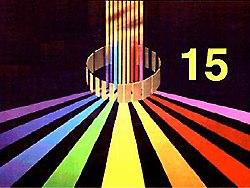


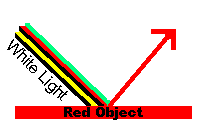 it
absorbs and the colors of light it reflects.
it
absorbs and the colors of light it reflects. 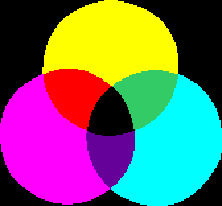

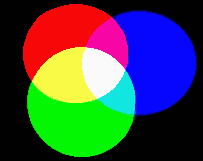 This can easily be demonstrated with three slide projectors. Let's assume
that a colored filter is placed over each of the three projector lenses-one red,
one green, and one blue.
This can easily be demonstrated with three slide projectors. Let's assume
that a colored filter is placed over each of the three projector lenses-one red,
one green, and one blue.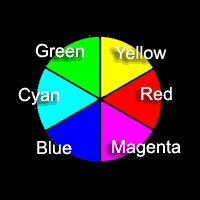 in
color television.
in
color television.
 goes
through a beam-splitter (on the right half of the drawing)
that separates the full-color picture into its red, green and blue components.
goes
through a beam-splitter (on the right half of the drawing)
that separates the full-color picture into its red, green and blue components.




 to figure out "C." In the same way, it's not always necessary to know the values
of all three primary colors, only two. Thus, color cameras can be made that have
only two chips.
to figure out "C." In the same way, it's not always necessary to know the values
of all three primary colors, only two. Thus, color cameras can be made that have
only two chips.